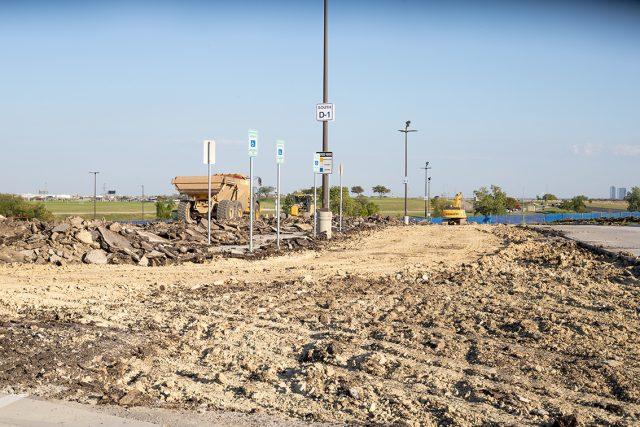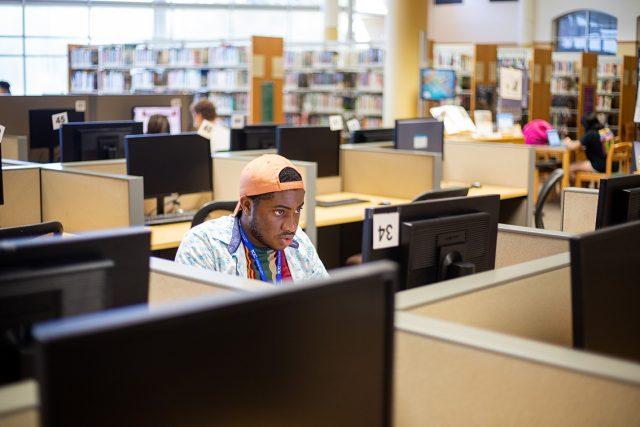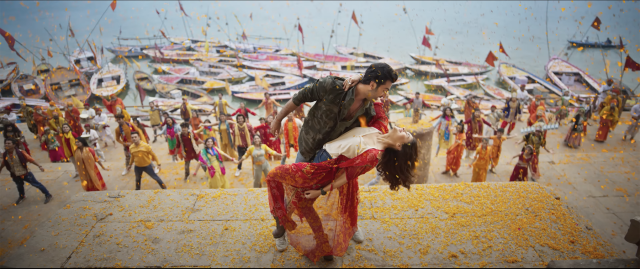
Photos by Joel Solis/The Collegian
OLLA MOKHTAR
campus editor
olla.mokhtar@my.tccd.edu
SE faculty introduces their artwork at the Faculty Biennial Corridor II via different mediums.
The Faculty Biennial, organized by instructor assistant Penelope Bisbee of the SE fine arts department, is a biannual event featuring the artwork of both adjunct and full-time faculty of the SE Campus.
The exhibit included nine artists that had multiple pieces of artwork shown to both students and faculty. The event started with a performance that happened on Sept. 15, it was an opening reception open to the public.
The performance was inspired by musical composer and adjunct professor Candance Alley who saw Assistant professor Dana Ferrara’s paintings “Plot I” and “Plot II” during an art exhibit for professors in the year 2020 and responded to both of them with music of her own. Both were then responded to again, by some artwork of Ferrara’s and they gave it the name “Duologue”.
The Assistant professor and artist Dana Ferrarra, who teaches Painting I and II and Design II, introduced her “Duologue.” The piece represented conversation between herself, a visual artist, and the musical composer Candace Alley and how they responded to each other’s work through art
Assistant professor Dana Ferrara, a full-time professor at SE Campus, explains how this “Duologue” came to be. First, adjunct professor Candace Alley saw Ferrara’s artwork “Plot I” and “Plot II” in a faculty exhibit in 2020. For Ferrara’s piece “Plot I”, it gave Alley the chance to respond to her through her own medium.
“She sent me a digital file of the song ‘Reflection’,” Ferrara said. “It was a piano solo and I felt compelled to do something in response because as an artist I felt like I wanted to say something back to her, almost like it was a conversation.”
For her second piece, “Plot II,” Alley also orchestrated a response to that.
“Her song was called ‘Sweet Spring’, and it also had this nice, delicate melody,” Ferrara said. “There was a saxophone, a guitar and piano, so I thought of layers and a scroll.”
With a background in piano , Ferrara interprets it into her painting along with some personal connections.
“The saxophone and the guitar, to me, sounded very warm and reminded me of a fallow field,” Ferrara said. “Because of a miscarriage I had, I felt like my body was a fallow field and that I need to grieve and rejuvenate made me think of that.”
After the performance on Sept. 15, artwork by many other professors was still available to view. For adjunct music instructor Brantley Sheffield, the painting also had a personal meaning.
“During the lockdown of the pandemic I was in Oklahoma where my parents live,” Sheffield said. “I started doing a lot of drawings from family photographs and it was a drawing of the dog. When I got back to my studio, I used the drawing as an inspiration for my painting.”
Sheffield’s process for accessing his end result comes from many steps.
“My process has turned into turning a bunch of photo images that I work from from my life; from people and places that I know,” Sheffield said. “I use that as a point of reference to make a drawing, a color drawing, and that color drawing sets up the structure of the painting.”
He also tries to form a connection between drawing and painting to better combine them with one another.
“Drawing is a very linear practice and I’m still constantly trying to find ways to further infuse my drawing and painting languages together,” Sheffield said. “Keeping the line quality is something important and my first thought was how I can merge these languages together and I thought that that line needs to be consistent.”
Similarly, adjunct instructor Roya Mansourkhani who teaches Art Appreciation and Drawing, uses pattern to signify something else, her Persian identity.
“When you are looking at my art you can see the pattern of Islamic words or Persian words,” Mansourkhani said. “The Farsi calligraphy of my original language allows me to show a story of identity and what is happening, especially for the women in Iran.”
One of Mansourkhani’s artworks incorporates the preservation of her culture and how it’s almost fading as the times become more modern.
“It’s sort of a tradition but the tradition is melting and eventually it will completely change,” Mansourkhani said. “This is showing the change in tradition and culture.”
Mansourkhani’s artworks also incorporate both a personal and social story of the women in Iran, highlighting the struggle of being a woman there.
“My self portrait is a show of identity,” Mansourkhani said. “When you look at the body, you see a jar with two handles that shows a lot of the fire coming from it. This is showing what’s happening inside me with my face being calm. But there are a lot of things that are happening here that others can not see.”
“CryOut” is the name of the drawing with a mixture of Arabic letters amplifying a unified theme throughout her various artworks.
“If you are open minded or are opposed to the government, the words explain how they come and get together,”Mansourkhanbi said. “ They are like a core of who you are and suddenly you cry out and explode with everything that’s inside of you.”
For people of different cultures and backgrounds, SE student Makayla Hoskinson still has appreciation for it.
“It’s really cool to see other people’s heritage along with art,” Hoskinson explains. “It gives you more of a perspective of their culture and everything else. It was very eye-opening.”
Penelope Bisbee foresaw this reaction and believed that anybody from all experiences with art can appreciate it as well.
“I think it can help people open up their minds a little bit,” Bisbee said. “ If you read anything about what the artist is trying to achieve, that sometimes helps to see how people put it out there in some kind of creative work.”




































